The following documents the events that led to the naming of asteroid 42531 McKenna
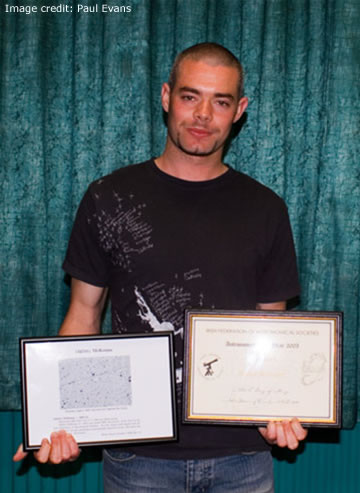 |
The East Antrim Astronomical Society hold their monthly meetings on the first Monday of every month. When this happens society members get the chance to meet like minded individuals who have a shared interest in many areas of astronomy, a time to share observations and make new friends and contacts. At each meeting the EAAS proudly introduce a high profile guest speaker who provides everyone with a fascinating lecture on various specialized areas of astronomy. Before the main guest takes to the stage it's often customary for a member of the society to perform a short 10 minute talk on a subject of his or her choice and tonight was no different.
As a keen astronomy enthusiast I seldom missed a meeting and made sure I was present for this one as the 10 minute slot was by an astronomer with 50 years of observing under his belt. John McConnell, a Fellow of the Royal Astronomical Society (FRAS) and prolific solar and lunar observer with an impressive background in astronomical history was planning a talk on the Moon which I was looking forward to very much. John took to the stage, switched on the overhead projector which displayed perhaps one of the earliest Moon images ever taken. From here he pointed out the major geographical features on the moon and the Apollo 11 landing site were men first set foot on the fine lunar soil when suddenly without warning John switched off the projector throwing the room into darkness while announcing that his presentation on the Moon was over which shocked everyone in the audience! - it had only lasted 30 seconds. He then adopted a serious expression informing us that he had official business to take care of concerning one of our members. He then produced a sheet of paper and began to read the following words...
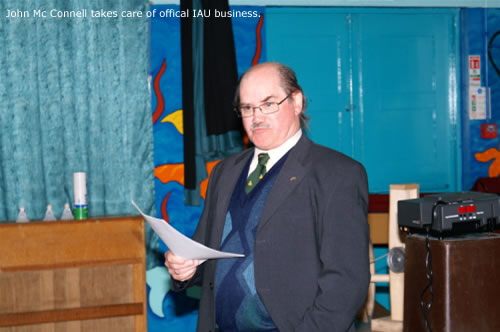 |
' Astronomy can sometimes be very rewarding, and never more so when it's good news. But with today's technology it's getting much harder to keep a secret. Back in December I approached my good friend Dr David Asher for some pointers regarding a wee bit of business concerning one of our members. As many of you probably know Dave was kind enough some years back to offer one of his asteroid discoveries to Terry Moseley following a suggestion during a casual conversation. So I was delighted, if somewhat embarrassed, when he offered one of his two remaining discoveries on my suggestion yet again. Due to the dedication and skill shown by the nominated individual, Dave insisted on offering it, and found it a great honour to do so. We are eternally grateful to him for that!'
For those who don't already know! The procedure or naming an asteroid is fairly strict. Firstly, it helps if you know someone who has made a few discoveries. You can then approach them and suggest a possible name. It is entirely up to the person who discovered the asteroid whether to agree or not.
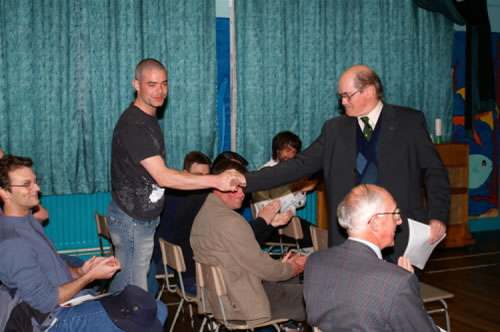 |
You then proceed on his/her instructions to prepare a suitable citation, which has got even harder to do in recent years, as you are tied to about 300 characters, and that includes the comas, full stops etc. It is the discoverers privilege to then submit it to the Minor Planet Center (MPC), and hopefully the International Astronomical Union (IAU) and Small Bodies Naming Committee (SBNC) will approve it.
The recipient is one of the most meticulous and prolific observers we have come to know in recent years. Not only does his interest cover such a wide range of astronomical and meteorological subjects, but he has also spent almost 1000 hours searching for that illusive comet of his own. It is mainly for this dedication that he is awarded this great honour. And if you haven't already worked out to whom I refer, let me quote the official citation...
(42531) McKenna - 1995 L J Discovered 1995 June 5 by D.J.Asher at Siding Spring.
Martin McKenna (b.1978) was named 2005 Astronomer of the year by the Irish Federation of Astronomical Societies. An avid visual comet hunter and all round observer, he also undertakes a photographic search for novae. The name was suggested by J.C.McConnell.
Martin, it gives me enormous pleasure in announcing that asteroid (42531) 1995 L J has been officially named as (42531) McKenna.
Many congratulations! very well deserved!''
After John's talk I was handed two framed pictures with the official citation and discovery image of 42531 McKenna with orbit diagram followed by a photo session. Dr David Asher - research astronomer at Armagh Observatory who specializes in asteroid, comet, and meteoroid orbits took to the stage and explained the current knowledge of the asteroid and its orbit within the main asteroid belt. David described the asteroid as having 'a slightly eccentric and chaotic orbit'. In the days after the award the media got word of the event which resulted in many newspaper articles and radio interviews which was great fun. My thanks goes to Dr David Asher and John Mc Connell for this unexpected surprise!
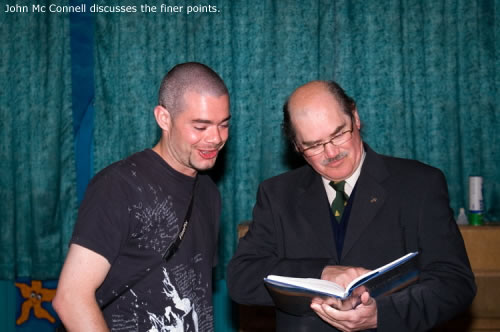 |
The following detailed information was sent to me by David via email...
''I looked at the results of the numerical integrations that I ran on the computer, to see what happens to the orbit of your minor planet. As I mentioned, because of the present relative orientations of the perihelia of Mars & Mc Kenna, it doesn't cross or overlap Mar's orbit currently. However, over timescale's of a few tens to a few hundreds of millennia, the gravitational effect of Jupiter and Saturn changes the eccentricity and the perihelion orientation of Mc Kenna (and of Mars) so that it changes between being Mars crossing and not being planet crossing. The effect of Jupiter & Saturn is all connected with the orientation (longitude) of the asteroid's perihelion relative to the perihelion longitudes of Jupiter & Saturn.
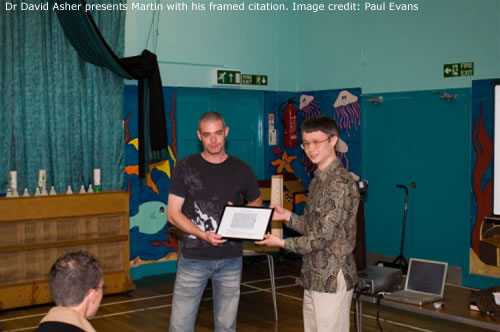 |
Someone who knows more about the maths of dynamics than I do might understand it better, but anyway, that (the behavior of Mc Kenna's perihelion distance
being driven by the perihelion orientation relative to Jupiter & Saturn) is what I've been able to notice from the integration results.
In summary, this effect means that the next epoch of being Mars crossing begins about 30,000 years from now, and this is a systematic, not random, effect of Jupiter & Saturn and so can be calculated quite accurately. After that, as I've said, the same effect will mean there'll be epochs of not being planet crossing interspersed with Mars crossing epochs.
During Mars crossing epochs, approaches to Mars occur (a collision is possible but unlikely). Once this starts to happen, the subsequent evolution becomes more and more random, because of the "chaotic dynamics" of close
approaches (i.e. you get a gravitational deflection one way or another and the time "horizon" up to which the evolution can be predicted is limited). Because Mars is small, e.g. compared to Earth and Venus, the likelihood is
that it will take quite some time for the random effect of close approaches to build up enough to put the asteroid on to a totally different kind of orbit. The integrations suggest that we're talking tens of millions of years, i.e. it COULD happen soon after 30,000 years but probably won't. Once the random effects have had enough time to build up, then anything (within reason) can happen, i.e. one can end up on kinds of orbit that are totally different from the present day orbit.
Out of 5 test particles integrated, 3 were still on (moderately) similar orbits after 40 million years, but one had been ejected from the solar system (having been Earth crossing for a little while) and the other fell into the Sun.
Solar in fall is (in my view) one of the most interesting dynamical phenomena that was studied during the 1990s and although the present orbit of (42531) McKenna is apparently unrelated to a solar in fall orbit, the random effect of close approaches can, with some probability, transfer the orbit to one where a sungrazing state or even solar in fall can occur So your minor planet is definitely fairly stable dynamically for another 30,000 years, with some chance of surviving, dynamically at any rate, for tens of millions of years. But in the medium to long term, it's certainly planet crossing''.
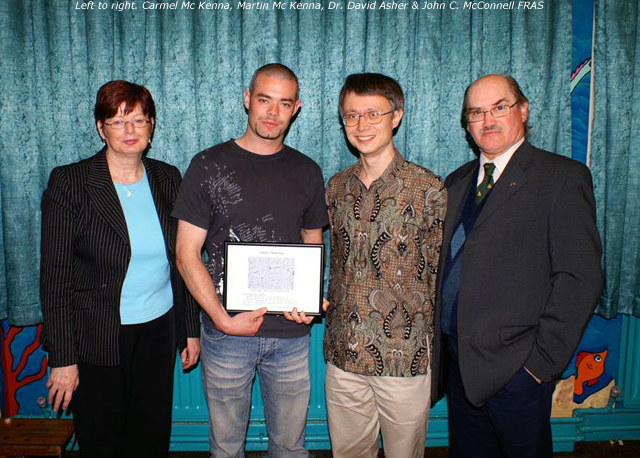 |
The variations in i are mainly an artifact of i being referred to the present day ecliptic, which of course has no significance in the dynamics of the solar system. If instead we considered the inclination relative to the orbital plane of Jupiter (which I didn't plot, I'm afraid!), which is more meaningful dynamically since Jupiter is the dominant influence, the variations in i would be smaller. So if a and i are roughly constant over tens to hundreds of kyr, the interesting thing is why q varies. Because it's q getting small that brings the asteroid within the orbit of Mars and allows the approaches that make it unstable. (Strictly, we need to see also how the q and pi of Mars vary, in order to see when the asteroid is Mars crossing, but let's not get carried away, the q-variation of the asteroid itself gives a good idea.)
Two main oscillations are evident in q, with periods of about 42 and 180 kyr. These correspond to the variations in the angles nu 5 and nu 6. Overall, therefore, Jupiter and Saturn - specifically, the orientation of their longitudes of
perihelion relative to that of the asteroid - cause systematic oscillations in q. So although (42531) McKenna isn't planet crossing now, it is planet crossing in the sense that it's inevitable (without any random effect) that
it becomes planet crossing repeatedly over tens and hundreds of kyr. When it's Mars crossing, random effects keep occurring. Over tens of millions of years (could be shorter, but it's less likely) the random effects could cause anything to happen. It may fall into the Sun, although we won't be around to know!''... David Asher
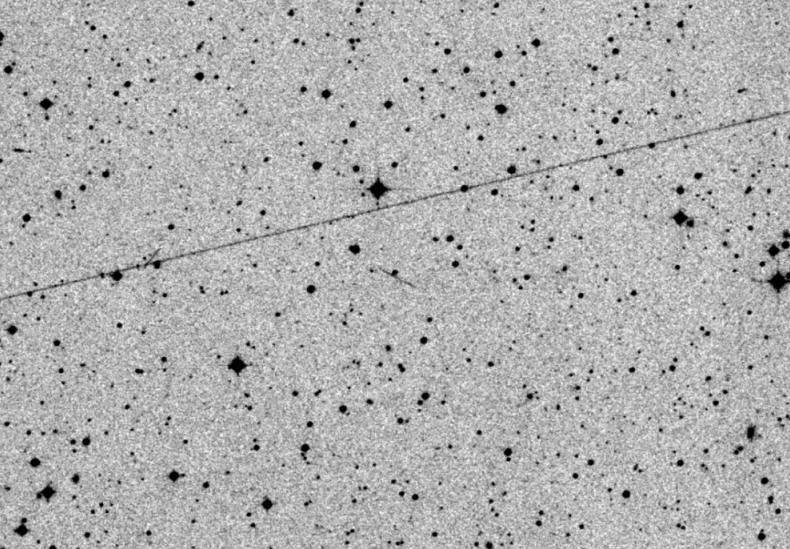 |
(Above) Original discovery image of 42531 McKenna from the digital sky survey kindly supplied by Dr. David Asher
The files plot a and plot q show the semi-major axis and perihelion distance of all 5 clones (clones = almost identical copies of the object, to show the different possible futures allowed by the chaotic evolution). There are 6 plots because the 5th clone is repeated on a different scale. This is the clone that went on to a very large orbit (I previously said "ejected from the solar system" which is probably what happened although strictly speaking I
didn't check - I stopped following things if the object went beyond 1000 AU from the Sun, as once it gets that far it's a lot more likely to be ejected eventually than to ever come back on to a small orbit).
The file plot.pdf shows the orbital elements so that we can see what happens over a shorter timescale. The symbols a, q, i, OMEGA, omega have their common meaning, i.e. semi-major axis, perihelion distance, inclination, longitude of ascending node, argument of perihelion. I use the symbol pi for the longitude of perihelion = OMEGA + omega, and nu 5 means pi of the asteroid minus pi of Jupiter (similarly nu 6 for Saturn). So when nu 5 = 0 the
asteroid's perihelion is aligned with Jupiter's perihelion, and when nu 5 = 180 the asteroid's perihelion is aligned with Jupiter aphelion, etc. The small jumps in that can be seen in plot.pdf are random (from approaches to Mars) but although they're different for each clone, over this timescale the differences aren't enough to affect the evolution of the other orbital elements. That is, over this timescale, can be regarded as roughly constant. Over many millions of years, it IS likely that the random differences build up enough to give totally different outcomes.
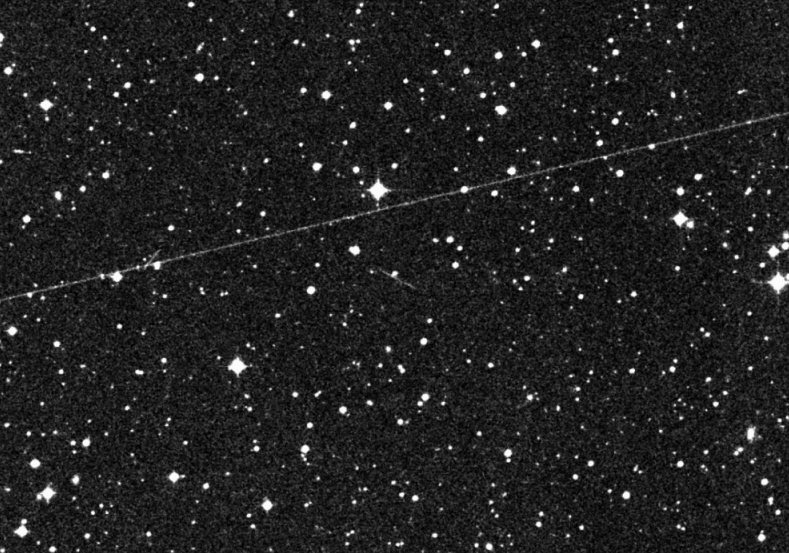 |
(Above) Same image with dark background. The asteroid is the short trail at centre. The longer trail is a passing satellite.
Mr. John McConnell born 1946 became interested in astronomy in the year 1957 when he saw comet C/1956 R1 Arend - Roland with his father. This has led to a life long interest in the subject with his observational career spanning 50 years. A long time member of the East Antrim Astronomical Society (EAAS), Irish Astronomical Association (IAA), Irish Astronomical Society (IAS) and a Fellow of the Royal Astronomical Society (FRAS). In 1999 he was the recipient of the Aiden P.Fitzgerald medal of the IAA for his popularization of astronomy. He served as Chairman of the EAAS for 8 years and was awarded by having asteroid 9929 McConnell named in his honor in 2001. He is well known among both professional and amateur astronomers and specializes in lunar, solar, and atmospheric observing and is a keen astrophotographer. He also maintains impressive records in the field of Irish astronomical history - work which is sought after by researchers around the world.
Dr Asher is one of the world's leading experts in Near Earth Objects (NEOs), currently dividing his time between Armagh and Japan where, at the invitation of the Japan Spaceguard Association, he is working at the Bisei Spaceguard Centre, Japan. However, in recent years has also worked closely with Robert McNaught of the Australian National University, in predicting so precisely, the Leonid Meteor Storms to within a few minutes.
Dr Asher was born in Edinburgh, and between school and university got a kind of student vacation job with Dr Victor Clube and Professor Bill Napier at the Royal Observatory EdinburghSolar In fall A Possibility?. It was here that he gained his interest in astronomy. Later, he did his research degree under Clube, and his D.Phil. thesis was on the Taurid meteor stream. He then went to work with Dr Duncan Steel's near-Earth asteroid programme in Australia, (since closed down by the Australian Government), learnt what a telescope was, (his words!), and got to know Robert McNaught.
It was during his time in Australia that he discovered a number of asteroids, one of which has recently been named (16693) Moseley in honour of Terry Moseley, former President of the Irish Astronomical Association, and good friend of the EAAS. His current job at Armagh is to work with the Director, Professor Mark Bailey, doing theoretical (computational) studies in solar system dynamics. The research project is about sun grazing and Jupiter grazing objects in particular, such as comets and asteroids.
Martin McKenna